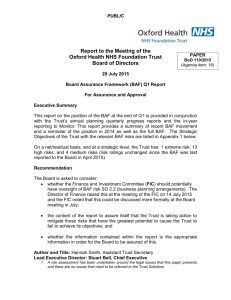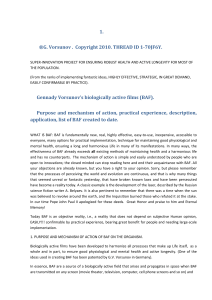Winners of Paper Presentations for 2014
advertisement
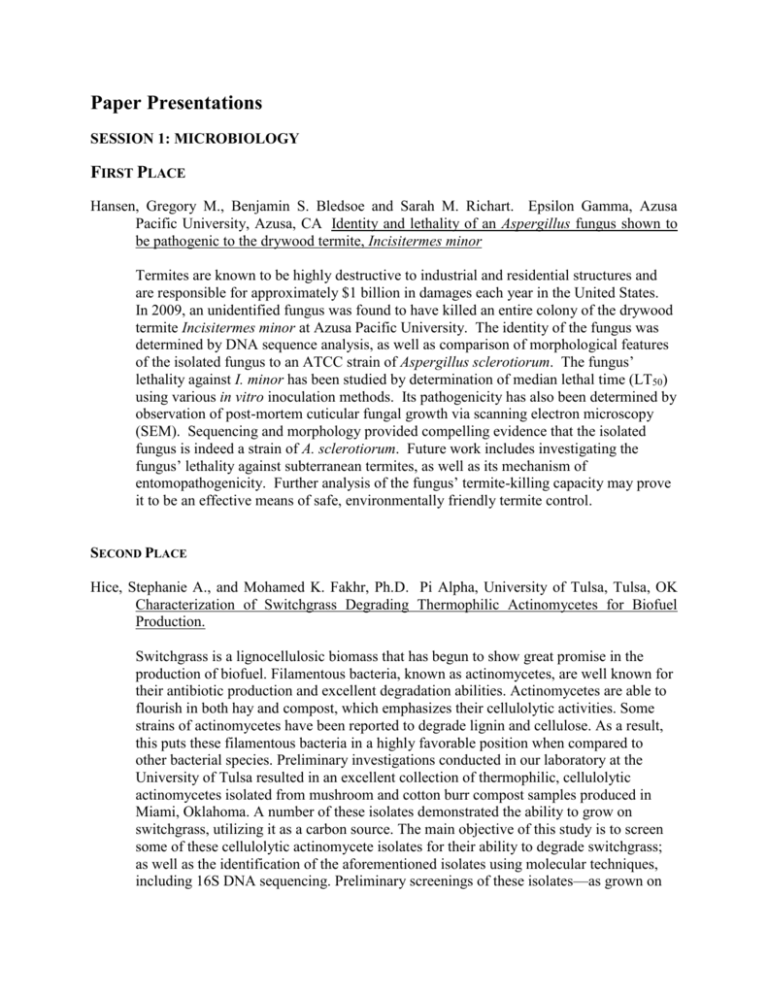
Paper Presentations SESSION 1: MICROBIOLOGY FIRST PLACE Hansen, Gregory M., Benjamin S. Bledsoe and Sarah M. Richart. Epsilon Gamma, Azusa Pacific University, Azusa, CA Identity and lethality of an Aspergillus fungus shown to be pathogenic to the drywood termite, Incisitermes minor Termites are known to be highly destructive to industrial and residential structures and are responsible for approximately $1 billion in damages each year in the United States. In 2009, an unidentified fungus was found to have killed an entire colony of the drywood termite Incisitermes minor at Azusa Pacific University. The identity of the fungus was determined by DNA sequence analysis, as well as comparison of morphological features of the isolated fungus to an ATCC strain of Aspergillus sclerotiorum. The fungus’ lethality against I. minor has been studied by determination of median lethal time (LT50) using various in vitro inoculation methods. Its pathogenicity has also been determined by observation of post-mortem cuticular fungal growth via scanning electron microscopy (SEM). Sequencing and morphology provided compelling evidence that the isolated fungus is indeed a strain of A. sclerotiorum. Future work includes investigating the fungus’ lethality against subterranean termites, as well as its mechanism of entomopathogenicity. Further analysis of the fungus’ termite-killing capacity may prove it to be an effective means of safe, environmentally friendly termite control. SECOND PLACE Hice, Stephanie A., and Mohamed K. Fakhr, Ph.D. Pi Alpha, University of Tulsa, Tulsa, OK Characterization of Switchgrass Degrading Thermophilic Actinomycetes for Biofuel Production. Switchgrass is a lignocellulosic biomass that has begun to show great promise in the production of biofuel. Filamentous bacteria, known as actinomycetes, are well known for their antibiotic production and excellent degradation abilities. Actinomycetes are able to flourish in both hay and compost, which emphasizes their cellulolytic activities. Some strains of actinomycetes have been reported to degrade lignin and cellulose. As a result, this puts these filamentous bacteria in a highly favorable position when compared to other bacterial species. Preliminary investigations conducted in our laboratory at the University of Tulsa resulted in an excellent collection of thermophilic, cellulolytic actinomycetes isolated from mushroom and cotton burr compost samples produced in Miami, Oklahoma. A number of these isolates demonstrated the ability to grow on switchgrass, utilizing it as a carbon source. The main objective of this study is to screen some of these cellulolytic actinomycete isolates for their ability to degrade switchgrass; as well as the identification of the aforementioned isolates using molecular techniques, including 16S DNA sequencing. Preliminary screenings of these isolates—as grown on either cellulose or switchgrass—have been conducted, and have tested positive for cellulase production. Some of the isolates were able to completely degrade switchgrass at 55 °C in less than ten days. Future work will focus on adjusting growth conditions to optimize switchgrass conversion to glucose. Using actinomycetes in the biomass conversion of switchgrass to glucose is advantageous, as the aerobic fermentation technology required for this process is currently available. Moreover, fermenting sugars for ethanol production is a successful industry, and has been at the forefront of research on sustainable energy sources. Offering an efficient method of obtaining ethanol, without exhausting the agriculture industry, is desirable. THIRD PLACE Chevalier, Judson C. and Crosby W. Jones. Epsilon Sigma, Angelo State University, San Angelo, TX. Growth Variation in Species of Staphylococcus Exposed to the Pseudomonas aeruginosa virulence factors HQNO and Pyocyanin Pseudomonas aeruginosa and Staphylococcus aureus are two common bacterial pathogens of humans that commonly cause co-infections such as those seen in the lungs of cystic fibrosis patients or in the wounds of burn patients. It is of interest to understand the interactions between these two species when they encounter one another in such situations. This study investigated the role of pyocyanin and 4-hydroxy-2heptylquinoline-N-oxide (HQNO) upon staphylococcal growth when applied as disc diffusion tests. These two compounds are virulence factors known to be secreted by P. aeruginosa, that have previously been thought to disrupt electron transport in staphylococci and thereby inhibit their aerobic growth. The results of the current study indicate that both substances have inhibitory activity upon various species of staphylococci. Interestingly, there appear to be two groups of staphylococcal response to these compounds. One is typical of S. aureus and the other is typical of various noncoagulase staphylococcal species. The data appear to support the theories that these two groups of staphylococci have different electron transport systems. SESSION 2: MOLECULAR AND CELLULAR BIOLOGY FIRST PLACE Hoffman, Carlie. Sigma Tau, Florida State University. Attention deficit/hyperactivity disorder (ADHD) and Kv1.3: Evaluating a potential disease model Attention deficit/hyperactivity disorder (ADHD) is a condition characterized by excessive levels of impulsivity, inattention, and hyperactivity. Mice subjected to deletion of the Kv1.3 potassium ion channel (knockout, KO) were observed to display behavioral symptoms of ADHD, indicating they may model this disorder. Due to the comorbidity between ADHD and anxiety disorders, the anxiety levels of KO and wildtype (WT) mice were determined as a precursor for the presence of additional ADHD-type behaviors using marble burying, elevated plus maze, and light-dark box testing. Because ADHD affects children and adults, inattentive and hyperactive behaviors were quantified for young and aged mice of both genotypes. Methylphenidate (MPH) or saline were also administered to the mice via oral gavage to determine the influence of MPH on behavior. KO mice trended towards having decreased anxiety levels compared to their WT counterparts. Object-based attention testing indicated young and aged KO mice had attention deficits and treatment with MPH ameliorated this symptom; however, metabolic chamber testing revealed KO mice had elevated activity levels, but MPH treatment did not reduce hyperactivity. Based on these findings, KO mice may be moderate behavioral models of ADHD; current research seeks to characterize the biochemical phenotypes of KO and WT mice. SECOND PLACE Dietrick, Barbara, Oscar Cabrera, Tiani Schwindt, & Timothy Megraw. Sigma Tau, Florida State University. Determination of the genetic network involved in MCPH disease. Autosomal recessive primary microcephaly (MCPH) causes reduced cerebral cortex development in afflicted individuals. This disease is genetically heterogeneous; associated with mutations in nine centrosome protein-encoded genes. We used centrosomin (cnn) mutant Drosophila as a model for MCPH disease. Cnn is required for assembly of a normal centrosome and to regulate its microtubule-organizing activity, but mutants can develop into adults that have an undefined neurological disorder. We used an RNA interference (RNAi) screen to suppress expression of genes in conjunction with cnn knockdown in the developing eye. Our goal was to identify modifiers (enhancers) of cnn mutant flies and discern the genetic network involved in MCPH disease. We discovered that genes controlling oxidative stress, Parkinson’s disease, autophagy, and microtubule regulation by the “augmin” complex showed a strong enhancement of cnn eye phenotype. To probe deeper, we focused on a mutant for an augmin complex gene called dgt4, which our lab recently isolated and mapped. Together, these findings suggest that oxidative stress, autophagy, and the augmin complex all play critical roles in the genetic network involved in the pathology of MCPH disease, with a surprisingly close relationship between cnn mutants and Parkinson’s disease. THIRD PLACE Slocum, Elizabeth and Irene Guttilla Reed, Rho Zeta, University of Saint Joseph. MicroRNA100 Targets IGF1R and Regulates Migration in a Human Breast Cancer Model of Epithelial to Mesenchymal Transition; Platform Presentation Luminal breast tumors typically have a lower risk of metastasis due to the epithelial nature of the cells. High levels of adhesion between epithelial cancer cells lower their invasive potential, motility, and migration rate. E-cadherin is one of the principle players in epithelial adhesion and responsible for their characteristics. Despite the nature of epithelial breast tumors, they may still undergo metastasis and is believed to be initiated through an epithelial to mesenchymal transition (EMT). EMT is the process by which epithelial cells acquire the phenotype of mesenchymal cancer cells, which have a loss of E-cadherin and enhanced invasive characteristics. Much research has recently focused on the regulation of EMT by microRNAs (short RNAs that inhibit gene expression). These data show that microRNA-100 is upregulated through a mammosphere induced EMT and targets insulin-like growth factor 1 receptor (IGF1R). Despite IGF1R’s involvement in tumorigenesis, its overexpression strengthens E-cadherin mediated adhesion in epithelial cells, contributing to its poor invasiveness. In addition, microRNA-100 was found to regulate migration, potentially due to the suppressed IGF1R expression leading to weakened adhesion. It is hypothesized that although IGF1R is utilized for tumorigenesis, it may be downregulated by microRNA-100 during EMT for a more metastatic phenotype. SESSION 3: ECOLOGY FIRST PLACE Amanda Stahlke, Epsilon Omicron, Colorado Mesa University. Preliminary studies on Coniatus spp., a natural nonnative enemy of the invasive shrub Tamarix spp., recently found in Colorado. The invasive shrub tamarisk, Tamarix spp., has dramatically altered riparian ecosystems in the Southwest United States. As tamarisk outcompetes native flora, these ecosystems show a loss of biodiversity, increased fire and flooding hazard, and significantly reduced water availability. Since tamarisk is difficult and costly to remove mechanically, the biological control agent, the northern tamarisk leaf beetle, Diorhabda carinulata, was introduced in 2001. In 2011, another specialist herbivore, the tamarisk weevil, Coniatus spp., was first observed in western Colorado on tamarisk during regular monitoring surveys. The non-native weevil has also been observed in California, Arizona, Nevada, New Mexico, Oklahoma, eastern Colorado, and Texas within less than a decade. Little is known about the non-native Coniatus spp., including its origin, its predicted range, and its effect on the tamarisk in conjunction with the biological control program. Coniatus spp. individuals from several sites in North America display at least two distinctive pupal casing morphologies and various adult color morphologies. The samples collected in Colorado, Nevada, Arizona and Utah were genetically compared to individuals from possible source populations in Italy and Turkey. Molecular genetic analysis of a mitochondrial DNA region containing the Cyctochrome Oxidase I gene was performed in an effort to identify genetic differences and construct a potential phylogenetic tree of Coniatus spp. Here we present molecular genetics and preliminary experimental phenological data in an effort to better understand implications of the presence of Coniatus spp. in North America. SECOND PLACE Ford, Rebecah, Ashley Wimer, Mike Ganger, and Greg Andraso. Theta Omega, Gannon University. Comparison of age and growth of the round goby (Neogobius melanostomus) from Lake Erie and a small invaded pond. The ability of the round goby (Neogobius melanostomus) to invade North American waters has received considerable attention. Given that dreissenid mussels(Dreissena polymorpha and Dreissena rostriformis bugensis) are major food items for both endemic and invading round gobies, it is hypothesized that the potential for round gobies to expand their range might be limited to the range of dreissenid mussels. The objective of this study was to compare age and growth of round gobies from Presque Isle Bay, where dresennid mussels are abundant, to a nearby invaded pond (Fairview Gravel Pit), where there is a lack of dreissenid mussels. Although the food habits of round gobies from the two sites differ, there appeared to be no differences between the two sites in terms of weight per unit body length. Age was determined through analyses of ground lapillar otoliths. Back calculation of length based on otolith size revealed no difference in growth in the first year between sites. Together, these results show that round gobies from the Gravel Pit site compare favorably to those from the Presque Isle site and suggest that the round goby may effectively colonize habitats in which their preferred prey of dreissenid mussels is not available. THIRD PLACE Berning, Matthew and Karen Osborn. Sigma Tau, Florida State University. Analysis of the Gut Contents of the Munnopsid Isopods Munneurycope murrayi and Acanthamunnopsis milleri. Two species of munnopsid isopods are present in the Pacific midwater community of Monterey Bay California. Their role as consumers in this community is poorly understood. Evidence from past non-quantitative laboratory studies and from observations in situ suggests that these species share certain feeding strategies and behaviors but differ in diet. Acanthamunnopsis milleri primarily occupies the upper extent of the midwater from 100-400m and is thought to be primarily herbivorous. Munneurycope Murrayi occurs in a lower region, from 400-1600m, and is thought to be an opportunistic omnivore. To further refine the diets of these species and determine if feeding preferences exist, guts of captured specimens were examined using scanning electron microscopy [SEM]. Composite images were constructed of the guts and were censused for type of identifiable particulate matter. The results of these counts will be compared to data from larvacean filters and to recorded plankton data to determine feeding selectivity. Results will also be compared between species to determine whether hypothetical patterns from previous studies are indeed represented in the gut contents of either species. The preliminary results of this study support a significant difference in diet between the two species and therefore reinforce the conclusions of previous nonquantitative studies. SESSION 4: CELL, ORGANISMAL AND DEVELOPMENTAL BIOLOGY FIRST PLACE Juhnnel O. Vera, Jonathan T. Henderson, Corey P. Neu, PhD. Zeta Lambda, University Of Puerto Rico at Aguadilla. A Mouse Model of In Situ Chondrocyte Nuclear Deformations Joints and cartilage are subjected on a daily basis to mechanical loading due to normal body movements and articular surface contact. Joints are subjected to natural stresses that mechanically stimulate cartilage cells (chondrocytes). Depending on their location in cartilage, chondrocytes receive compressive forces that will deform the cell membrane and nucleus. Recent studies suggest that nuclear mechanics have an important role in cartilage homeostasis, but deformation of the nucleus has not been performed in vivo. Toward this end, we used a cadaveric mouse model with simulated compressive forces and confocal imaging to directly measure nuclear deformations. Mice were sacrificed by CO2 overdose, and their tibiofemoral joints were surgically exposed. Joints were fixed to a custom loading apparatus that simulates a normal flexing movement to mechanically stimulate the chondrocytes. Nuclear imaging was carried out before and after stimulation with a DRAQ5 DNA dye to compare nuclear deformations. Deformations in situ were observed to be heterogeneous between different nuclei. Future studies will extend these experiments to measurements in live mice. We anticipate that development of a new in vivo methodology will allow researchers to conduct direct experiments linking mechanical force to gene expression, significant to the field of mechanobiology. SECOND PLACE Vincent, Jessica and Rajpal Sagoo. Psi Rho. University of North Georgia. Autointegration Factor-Like (BAF-L) Interacts with Histones. Barrier-to- Barrier-to-Autointegration Factor (BAF) is a conserved DNA binding protein with cellular roles in nuclear assembly, regulation of chromatin structure, and gene expression. The regulation of chromatin structure by BAF is most likely mediated through its interactions with DNA and histones. BAF is regulated through phosphorylation, but there are other potential modifications of BAF that remain unknown. Barrier-toAutointegration Factor-Like (BAF-L) is a protein that is 40% identical and 53% similar to BAF at the amino acid level. Recombinant BAF-L can form stable homodimers and can heterodimerize with BAF in vitro and in vivo. Although BAF-L does not significantly bind to DNA and other partners of BAF, it can interact with BAF in the presence of DNA. These distinct biochemical characteristics of BAF-L suggest that it might regulate BAF function through formation of BAF/BAF-L dimers. We hypothesize that binding of BAF-L may help regulate BAF interactions with histones and DNA. Preliminary data for our research group suggests that BAF-L can, like BAF, bind to histones H1 and H3. We will confirm this preliminary finding and extend it by testing BAF-L binding to histones through several protein-protein interaction assays. THIRD PLACE Stephens, Michael. Rho Theta, Thomas More College. Spi-C Negatively Regulates Eosinophil Peroxidase Production in Murine Eosinophils. Eosinophils are granular white blood cells that are important components of immune responses through the release of their granules like eosinophil peroxidase (EPO) upon activation. The release of this enzyme due to lysis or activation can be quantified with a colorimetric EPO assay. The assay can identify regulators of EPO expression and release, such as Spi-C, a transcription factor that is hypothesized to regulate expression of granule proteins in eosinophils. We hypothesize that Spi-Cko cells produce and release more EPO upon activation. Murine low density bone marrow was cultured for 8, 11, 14, or 16 days in the presence of 10 ng/mL interleukin-5 (IL-5); resuspended in Roswell Memorial Park Institute (RPMI) media with 0.5% BSA; and treated for 2 hours with activators or lysis reagents. An EPO assay was performed and the color change was read at 492 nm. Phorbol myristate acetate (PMA) at concentrations of 100 ng/mL and 500 ng/mL induced dose-dependent release of EPO through activation of the cells plated at an optimal concentration of 1000 cells/µL. Relative to wild-type cells, Spi-Cko cells upon lysis released greater EPO after 14 and 16 days of culture. At day 8 of maturation, Spi-Cko cells released more EPO than wild-type cells upon activation with 100 ng/mL PMA. These findings confirm that Spi-C negatively regulates the production and release of EPO in eosinophils, as its absence leads to greater release after activation or lysis. Future directions will involve further analysis of the role of Spi-C in the expression of eosinophilic granular proteins. HONORABLE MENTION Weisner, Zachary M. and Dr. Olivia S. Long. Theta Pi, University of Pittsburgh Greensburg. Utilizing E. coli to Express dsRNA to Inhibit Molecular Pathways in C. elegans Alpha-1 Antitrypsin (α-1 AT) deficiency is a common genetic disorder that affects 1 in 2,000 individuals in the USA. Additionally, over 20 million people have been identified as carriers for this genetic disorder. In severe cases, α-1 AT deficiency can cause substantial lung and liver damage, which if left untreated could result in death and there are no current available treatments. Alpha-1 protein is produced in the liver, travels in the bloodstream and utilized in the lungs to protect healthy lung tissue from harmful destruction by elastase. A common single amino acid substitution, located at E342K (ATZ) was identified in α-1 AT deficient humans. When this specific mutation occurs two phenotypes can result: 1) ATZ can polymerize in the liver causing cellular toxicity 2) inhibits alpha-1 antitrypsin from inhibiting elastase which can result in lung disease. Currently; little is known about the cellular mechanisms that clear the accumulated proteins in the liver. Therefore, an investigative study utilizing C. elegans model of ATZ was performed in order to help determine the cellular mechanisms that dispose of accumulated proteins. Specifically RNA interference was utilized to knockdown expression of specific genes. This investigation examined genes involved in the heatshock pathway (HSP), unfolded protein response (UPR), and insulin signaling pathway (IS). Phenotypic analysis including: embryonic lethality, protein aggregation expression, and longevity, was completed after knockdown of genes to determine effect on ATZ accumulation. Currently with our preliminary data suggests that the heat-shack pathway may play a role in ATZ accumulation. Determining the mechanism of protein accumulation in the investigation of C. elegans may lead to possible drug targets and therefore the development of a treatment which may alleviate those diagnosed with this disorder.
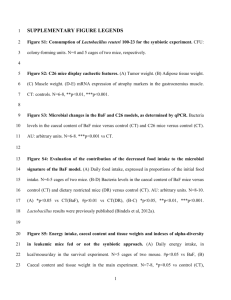


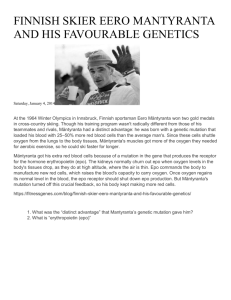
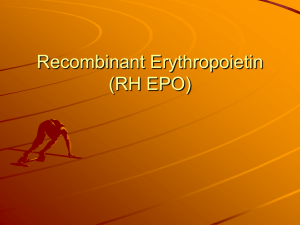
![Historical_politcal_background_(intro)[1]](http://s2.studylib.net/store/data/005222460_1-479b8dcb7799e13bea2e28f4fa4bf82a-300x300.png)
